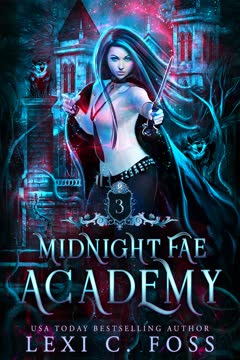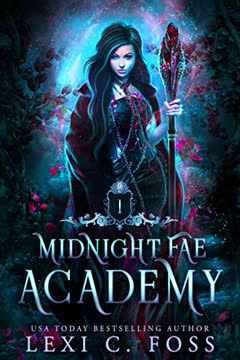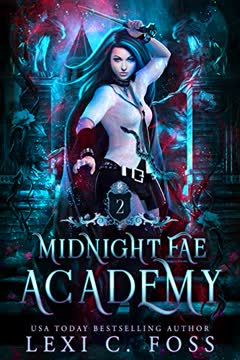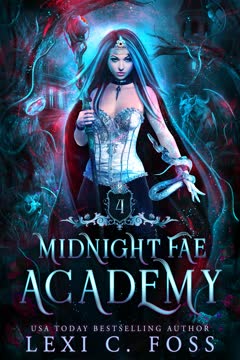Plot Summary
Prologue: Bonds and Betrayals
Aflora, an Earth Fae Royal, is bound by ancient magic and political machinations. As a child, she was bonded to Zakkai, a powerful Quandary Blood, to protect her from the deadly politics of the Midnight Fae. This bond was orchestrated by their parents, but the emotional and magical consequences linger. Now, as a young woman, Aflora finds herself at the center of a revolution, manipulated by councils, kings, and mates, all vying for her allegiance and power. Her story begins with betrayal, secrets, and the realization that her life has never truly been her own.
Council's Deadly Game
The Midnight Fae Council, led by Constantine Nacht, is ruthless in its pursuit of power. They see Aflora as a pawn, using her as bait to draw out the elusive Quandary Bloods. The Council's machinations are cold and calculated, disregarding her autonomy and safety. Kols, the Elite Blood Prince, is torn between his duty to the Council and his growing feelings for Aflora. The Council's willingness to sacrifice Aflora for their own ends sets the stage for a deadly game of politics, betrayal, and survival.
The Quandary Blood Mate
Zakkai, Aflora's childhood friend and secret mate, reemerges as the Source Architect of the Quandary Bloods. His presence is both a comfort and a threat, as he holds the key to Aflora's mysterious powers and her forgotten past. Zakkai's methods are enigmatic and often cruel, using riddles and magical tests to force Aflora to confront her own strength and the truth of their bond. His agenda is unclear—does he want to protect Aflora, or use her for his own revolutionary goals?
Zakkai's Riddles
Zakkai traps Aflora in a web of magical riddles and memory spells, forcing her to relive their childhood and the origins of their bond. Through these trials, Aflora uncovers the truth: her powers are not an abomination, but the result of a deliberate merging of earth and quandary magic. Zakkai's riddles are both a test and a training, preparing her for the war to come. Yet, his refusal to give her straight answers fuels her frustration and mistrust.
Paradigms and Power Plays
Aflora is held in a secret paradigm—a magical pocket reality—crafted by Zakkai. Here, she is isolated from her other mates, Shade, Zeph, and Kols, who are left scrambling to find her. The paradigm is both sanctuary and prison, a place where Aflora's powers can grow but also where Zakkai can control her. Meanwhile, Shade and the others navigate the treacherous politics of the Midnight Fae, forming uneasy alliances and uncovering the Council's true intentions.
Memory's Hidden Roots
Through a series of memory spells, Aflora relives her childhood with Zakkai, the trauma of her parents' deaths, and the original purpose of her bond. She learns that her parents died protecting the Quandary Bloods, and that her own existence is a living legacy of rebellion. These revelations reshape her understanding of herself—not as a pawn, but as a potential queen and revolutionary.
The Council's Trap
The Council, aided by traitors like Dakota, sets a trap for Aflora and her mates at the annual Blood Gala—a political event celebrating the genocide of the Quandary Bloods. Constantine's plan is to use Aflora's power as proof of the danger of abominations, justifying a new purge. The mates, now partially reunited through dreamwalking, realize the Council's true aim and scramble to protect Aflora and themselves.
Dreamwalking and Alliances
Aflora, with Zakkai's reluctant permission, learns to dreamwalk—entering the dreams of her mates to communicate and strategize. These dream meetings become a sanctuary for emotional healing, sexual connection, and plotting resistance. The mates, once divided by suspicion and rivalry, begin to trust each other, forming a united front against the Council and Zakkai's own unpredictable agenda.
The Blood Gala Looms
The Blood Gala, a symbol of Midnight Fae supremacy and Quandary Blood oppression, becomes the stage for the story's climax. Disguised and masked by enchanted jewelry, Aflora and Zakkai infiltrate the event, while Zeph and Kols try to protect her from within. The Council's trap is sprung, and the true nature of the Midnight Fae's corruption is revealed to all.
Constantine's Coup
Constantine Nacht orchestrates a coup, using the chaos of the Blood Gala to strip Kols of his power and publicly execute him for the crime of loving an abomination. The act is both a personal and political attack, meant to terrify the populace and cement Constantine's return to power. Aflora's grief and rage at Kols's death trigger a catastrophic explosion of her powers, threatening to destroy everyone present.
Death and Resurrection
In the aftermath of Kols's death, Aflora's mates—Zeph, Shade, and even Zakkai—combine their unique magics to anchor Kols's soul and resurrect him. This act of defiance forges an unbreakable bond between all of them, blending their powers and destinies. The resurrection is a miracle, but it comes at a cost: the world now sees them as true abominations, and the war is inevitable.
The Queen's Fury Unleashed
Aflora, transformed by grief and love, unleashes her full power as a hybrid of life and death. She is no longer a pawn, but a queen in her own right, capable of both creation and destruction. Her mates rally around her, and together they vow to bring down Constantine and the corrupt Council. The revolution has a new leader, and the old order trembles.
The New Abomination
The magical resurrection and merging of powers create something unprecedented: a circle of mates who are each part abomination, each carrying a piece of Aflora's earth and quandary magic. This new family is both feared and revered, a living challenge to the old hierarchies and prejudices of the Midnight Fae.
Reforging the Circle
The mates, once fractured by secrets and betrayals, now find strength in their unity. Through blood, sex, and shared purpose, they forge a new circle—one that is equal, passionate, and unbreakable. Aflora's leadership is no longer in question; she is the heart of their revolution.
Shade's Gambit
Shade's manipulation of time and fate is revealed as a desperate gamble to save Aflora and Kols from endless cycles of tragedy. By working with Paradox Fae and risking his own soul, Shade ensures that this time, the outcome is different. The cost is high, but the circle is finally whole.
The War Begins
With Constantine's coup and the public display of Aflora's power, the fae world is plunged into open war. The mates must navigate shifting alliances, betrayals, and the threat of annihilation. The old rules no longer apply, and survival depends on embracing their abominable nature.
Paradigm Sanctuary
The mates retreat to a hidden paradigm, a magical sanctuary where they can heal, plan, and love without fear. Here, Aflora's power flourishes, and the circle grows stronger. But the outside world is closing in, and the sanctuary is only a temporary reprieve.
Nightmares and New Reigns
As the book ends, Aflora is confronted by Constantine in a nightmare vision, foreshadowing the final battle to come. She is no longer the frightened pawn of others' games, but a queen ready to claim her crown and rewrite the rules of the Midnight Fae forever.
Characters
Aflora
Aflora is the emotional and magical center of the story—a young woman whose life has been shaped by the ambitions and fears of others. Initially a pawn, she is manipulated by councils, mates, and ancient magic, but her journey is one of awakening and self-assertion. Her relationships with her mates are complex, blending love, lust, and political necessity. Psychologically, Aflora is torn between her nurturing earth nature and the destructive power forced upon her. Her greatest growth comes from embracing both, becoming a leader who can create and destroy as needed. Her arc is about reclaiming agency, forging unity, and redefining what it means to be "abomination."
Zakkai
Zakkai is both Aflora's first love and her greatest challenge. As the Source Architect of the Quandary Bloods, he is a master of riddles, memory magic, and paradigm creation. His motives are layered: he wants justice for his people, revenge on the Nacht family, and Aflora's love. Psychologically, Zakkai is shaped by childhood trauma, duty, and a deep loneliness. His development is a slow surrender to vulnerability, learning to trust and be trusted. His relationship with Aflora is a dance of power, pain, and eventual partnership.
Kols (Kolstov Nacht)
Kols is the heir to the Midnight Fae throne, raised to be a weapon of the Council but yearning for something more. His love for Aflora and his mates puts him at odds with his family and destiny. Kols's arc is one of sacrifice—he is stripped of power, killed, and resurrected, emerging as a new kind of fae. Psychologically, he is driven by loyalty, guilt, and a desperate need for belonging. His death and rebirth mark the turning point of the story, transforming him from pawn to revolutionary.
Zeph (Zephyrus)
Zeph is Aflora's fierce protector and Kols's loyal companion. He is defined by his need for control, his physicality, and his willingness to submit for those he loves. Zeph's psychological journey is about letting go of rigid roles and embracing vulnerability. His bond with Aflora and Kols is both sexual and emotional, and he becomes a pillar of the new circle.
Shade (Shadow)
Shade is the most mysterious of the mates, a Death Blood with the ability to manipulate time and fate. He is both a trickster and a martyr, carrying the burden of countless failed timelines. Psychologically, Shade is haunted by guilt and the knowledge of what could have been. His arc is about accepting the limits of control and making the ultimate sacrifice to save his chosen family.
Constantine Nacht
Constantine is the architect of the old order—a patriarch who uses fear, violence, and tradition to maintain power. He is both a symbol and an active agent of oppression, orchestrating coups and purges. Psychologically, Constantine is driven by fear of change and a belief in his own supremacy. He is the primary antagonist, representing everything the new circle must overcome.
Dakota
Dakota is a power-hungry fae who betrays Aflora and her mates to the Council. She is motivated by jealousy, ambition, and a desire for proximity to power. Psychologically, Dakota is insecure and opportunistic, serving as a foil to Aflora's reluctant leadership.
Laki
Laki is a survivor of the Quandary Blood purge and Zakkai's mentor. He is pragmatic, sometimes cold, and focused on the long game of revolution. His relationship with Zakkai is fraught with expectation and disappointment, and he represents the older generation's scars and hopes.
Zenaida
Zenaida is Shade's grandmother and a symbol of the possibility of reformation. She advocates for diplomacy and unity, standing in contrast to Zakkai's retribution. Psychologically, she is wise but weary, carrying the weight of past failures.
Tray and Ella
Tray and Ella are secondary but important characters, representing the next generation of fae caught in the revolution. Their loyalty and love provide emotional grounding for Kols and Aflora.
Plot Devices
Bond Magic and Mating Circles
The story's central device is the magical bond—mating ties that are both emotional and political. These bonds can be formed, broken, and reforged, but always at a cost. The circle of mates is both a source of power and vulnerability, forcing characters to confront their deepest fears and desires. The merging of different bloodlines (Earth, Quandary, Death, Warrior, Elite) is both a plot engine and a metaphor for breaking old prejudices.
Paradigms and Memory Spells
Paradigms—magical pocket realities—are used for sanctuary, imprisonment, and training. Memory spells reveal hidden truths, force characters to relive trauma, and challenge their sense of self. These devices allow for nonlinear storytelling, foreshadowing, and the gradual revelation of secrets.
Council Intrigue and Political Betrayal
The Council's manipulations, Constantine's coup, and Dakota's betrayal create a web of shifting alliances and constant danger. The Blood Gala serves as a narrative crucible, where all the political and personal tensions explode.
Resurrection and Abomination
Kols's death and magical resurrection are the story's climax, breaking the rules of the fae world and creating a new kind of being. This device is both literal and symbolic, representing the possibility of change, the cost of revolution, and the birth of a new order.
Dreamwalking and Time Manipulation
Dreamwalking enables the mates to connect, heal, and strategize even when physically separated. Shade's time magic introduces the idea of multiple timelines and the burden of failed outcomes, raising the stakes and deepening the sense of fate.
Analysis
Midnight Fae Academy: Book Three is a dark, sensual, and emotionally charged tale of revolution, identity, and the cost of change. At its heart, the book is about breaking cycles—of violence, prejudice, and manipulation—by forging new bonds and embracing the power of difference. Aflora's journey from pawn to queen mirrors the story's larger themes: the necessity of questioning tradition, the pain and beauty of hybrid identities, and the transformative power of chosen family. The narrative uses romance and magic as metaphors for political and personal liberation, challenging the reader to consider what it means to be "abomination" in a world built on exclusion. The book's lessons are clear: true power comes from unity, vulnerability, and the courage to rewrite the rules. As the revolution begins, the story leaves us with a sense of hope and dread—change is possible, but it always comes at a price.
Last updated:
FAQ
Synopsis & Basic Details
What is Midnight Fae Academy: Book Three about?
- Aflora's Fated Revolution: Midnight Fae Academy: Book Three plunges Aflora, an Earth Fae Royal, deeper into a complex war for the future of the Midnight Fae, where she discovers her childhood bond to Quandary Blood King Zakkai and navigates treacherous political landscapes. She is forced to confront hidden truths about her past, her powers, and the corrupt Council that seeks to control her.
- Uniting a Fractured Mating Circle: The narrative centers on Aflora's evolving relationships with her four Midnight Fae mates—Kols, Zeph, Shade, and Zakkai—as they move from suspicion and rivalry to a unified front. Through dreamwalking, shared trauma, and intimate connections, they forge an unbreakable bond, challenging the very definition of "abomination" in their world.
- The Spark of Rebellion: The story culminates in a dramatic confrontation at the annual Blood Gala, where the corrupt Council attempts to publicly execute Kols. This act of betrayal ignites Aflora's full power, leading to Kols's miraculous resurrection and the official beginning of a revolution against the tyrannical rule of Constantine Nacht.
Why should I read Midnight Fae Academy: Book Three?
- Deep Dive into Fae Politics: Readers who enjoy intricate world-building and political intrigue will be captivated by the layers of deception, ancient feuds, and power struggles within the Midnight Fae realm. The book meticulously unravels a history of prejudice and manipulation, offering a rich backdrop for the unfolding revolution.
- Intense Emotional & Relational Arcs: The story excels in its psychological and emotional depth, exploring themes of identity, betrayal, and the transformative power of love and chosen family. Aflora's journey from pawn to queen, alongside her mates' complex motivations and sacrifices, provides a compelling and emotionally resonant reading experience.
- Unique Reverse Harem Dynamics: For fans of why-choose romance, this installment pushes boundaries with its exploration of multiple, interconnected mating bonds. The mates' individual relationships with Aflora, and their evolving dynamic as a collective, offer a fresh take on shared intimacy, trust, and mutual empowerment.
What is the background of Midnight Fae Academy: Book Three?
- Ancient Quandary Blood Genocide: The core conflict stems from a millennium-old genocide orchestrated by Constantine Nacht, the Elite Blood patriarch, against the Quandary Bloods. This historical event, driven by fear of their inherent power and a desire to establish a male-dominated hierarchy, forms the bedrock of the ongoing revolution.
- Corrupt Midnight Fae Council: The current Midnight Fae Council, heavily influenced by Constantine and his Elite Blood lineage, maintains power through deception, violence, and the suppression of "abominations" (fae with mixed bloodlines). Their actions, including the murder of Aflora's parents and the manipulation of her destiny, fuel the mates' desire for retribution and reformation.
- Hidden Paradigms & Time Manipulation: The world features secret magical pocket realities called paradigms, used for sanctuary and strategic hiding, as well as the rare and dangerous ability of time manipulation, primarily wielded by Death Bloods and Paradox Fae. These elements create a complex, multi-layered setting where past, present, and future are constantly in flux, impacting character choices and the unfolding plot.
What are the most memorable quotes in Midnight Fae Academy: Book Three?
- "Retribution. Reformation. Two sides of a revolution, both vying for my allegiance. Well, I pick neither side.": This opening declaration by Aflora powerfully sets the stage for her journey, highlighting her refusal to be a pawn and her determination to forge her own path, embodying the central "Aflora motivation" for agency and self-determination.
- "Death isn't always the solution... Unless you want to take over the mantle of slaughtering and ending lives?": Aflora's sharp retort to Zakkai's call for retribution encapsulates the moral dilemma at the heart of the revolution. It questions the cycle of violence and challenges the idea that justice can only be achieved through further bloodshed, a key "themes in Midnight Fae Academy: Book Three" debate.
- "I'm a mixture of both. So let's see what happens when life marries death, shall we?": From the "About Book Four" section, this quote perfectly summarizes Aflora's transformation and the unique power of her "abomination" status. It signifies her acceptance of her dual nature and her readiness to wield both creation and destruction as the future Queen of the Midnight Fae, a powerful statement on "Aflora's identity explained."
What writing style, narrative choices, and literary techniques does Lexi C. Foss use?
- First-Person Multi-POV Narrative: The story primarily uses Aflora's first-person perspective, offering intimate access to her thoughts and emotions, but frequently shifts to the first-person perspectives of her mates (Zakkai, Kols, Shade, Zeph). This narrative choice provides a comprehensive, albeit sometimes conflicting, view of events, deepening character understanding and building suspense.
- Sensory-Rich & Evocative Language: Foss employs vivid, sensual descriptions, particularly in intimate scenes and magical displays, immersing the reader in the characters' experiences. The prose often focuses on tactile sensations, scents, and internal feelings, creating a highly immersive and emotionally charged atmosphere
Review Summary
Midnight Fae Academy is a highly praised paranormal reverse harem series with an average rating of 4.39 out of 5. Readers love the intricate plot, complex characters, and steamy romance scenes. The third book in the series is particularly praised for its twists, revelations, and character development. Many reviewers express excitement for the upcoming fourth book, noting the cliffhanger ending. Some criticisms include pacing issues and plot holes, but overall, the series is recommended for fans of dark fantasy and reverse harem stories.
Midnight Fae Academy Series
Download PDF
Download EPUB
.epub digital book format is ideal for reading ebooks on phones, tablets, and e-readers.









